Hamburg, in the north of Germany, is a brilliant place to spend a few days. There are loads of things to do in Hamburg – from the one-of-a-kind Miniatur Wunderland, to a chocolate museum, urban beaches, iconic music history and UNESCO World Heritage sites.
I loved my birthday trip to Hamburg, and I’m excited to share what I think are the 21 top things to do in Hamburg. If I’ve missed your favourite Hamburg attraction, please let me know in the comments – I’m sure I’ll be heading back to Hamburg!
Here are my 21 favourite things to do in Hamburg
1. Be amazed at Miniatur Wunderland
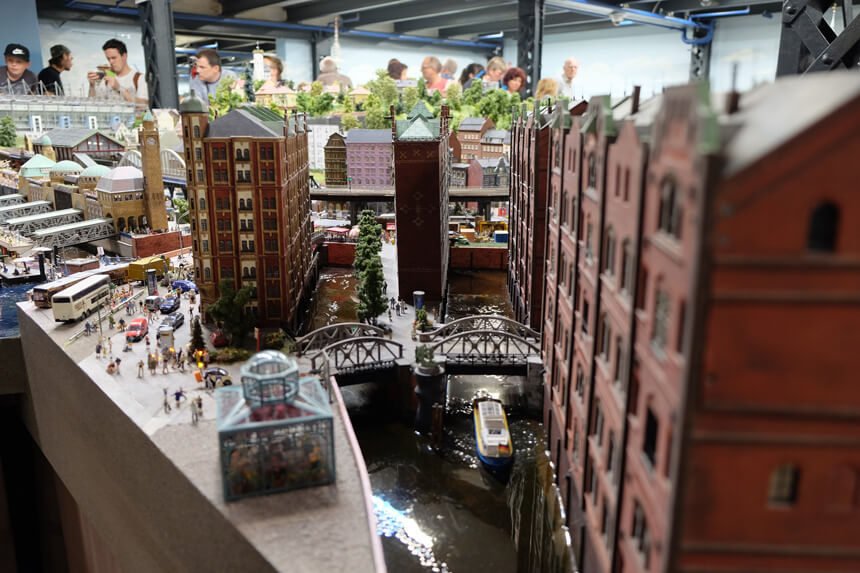
Miniatur Wunderland should be top of your list for any visit to Hamburg. Miniatur Wunderland is the world’s biggest model train set, but wait – even if that doesn’t sound quite your thing, it’s completely amazing and you definitely shouldn’t miss out.
Set over six large rooms in an old warehouse, Miniatur Wunderland lets you take a tour around the world in model form. The city of Hamburg and landmarks from the USA, Austria, Switzerland, Scandinavia and Italy are all modelled in incredible detail, and they’re adding new sections all the time. There’s so much going on in every part of Miniatur Wunderland – as well as the painstaking models of real-life landmarks, there are also funny little scenes to discover. The more you look and watch, the more you’ll get out of your visit.
Miniatur Wunderland is not only one of the best things to do in Hamburg, it’s one of the most popular attractions in the whole of Germany – to be sure of getting in, it’s best to book your tickets in advance.
2. Wander through the Speicherstadt
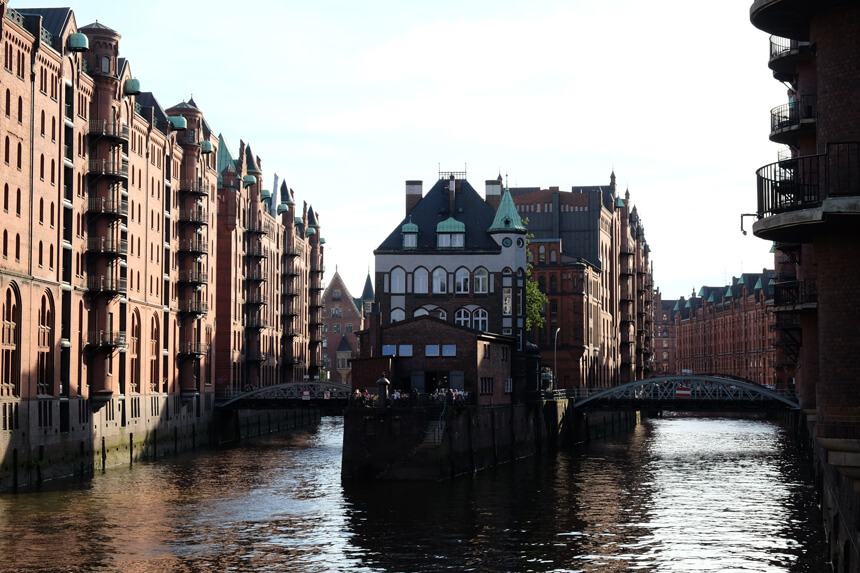
The area where you’ll find Miniatur Wunderland is called Speicherstadt. It’s one of the largest and most historic warehouse districts in the world, and is a must-see attraction for visitors to Hamburg. Since 2015 it’s even been a UNESCO World Heritage Site, the first in Hamburg.
The Speicherstadt’s tall, red-brick warehouses were built between the late 1800s and 1920s, and over the years have provided the facilities for Hamburg’s trade in carpets, coffee, tea, spices and more – trades which continue to this day in these historic buildings.
As well as businesses and Miniatur Wunderland, you’ll also find a museum about the Speicherstadt in one of the warehouse buildings, plus the Hamburg Dungeon, a spice museum, the Maritime Museum, a museum of early racing cars and Dialogue in the Dark, a sensory experience which helps sighted people understand what it’s like to experience the world without being able to see.
The Speicherstadt is an evocative place to visit either on foot or by taking one of the many boat tours which sail through the Speicherstadt canals.
Read more: Where to stay in Hamburg
3. See the view from the Elbphilharmonie concert hall
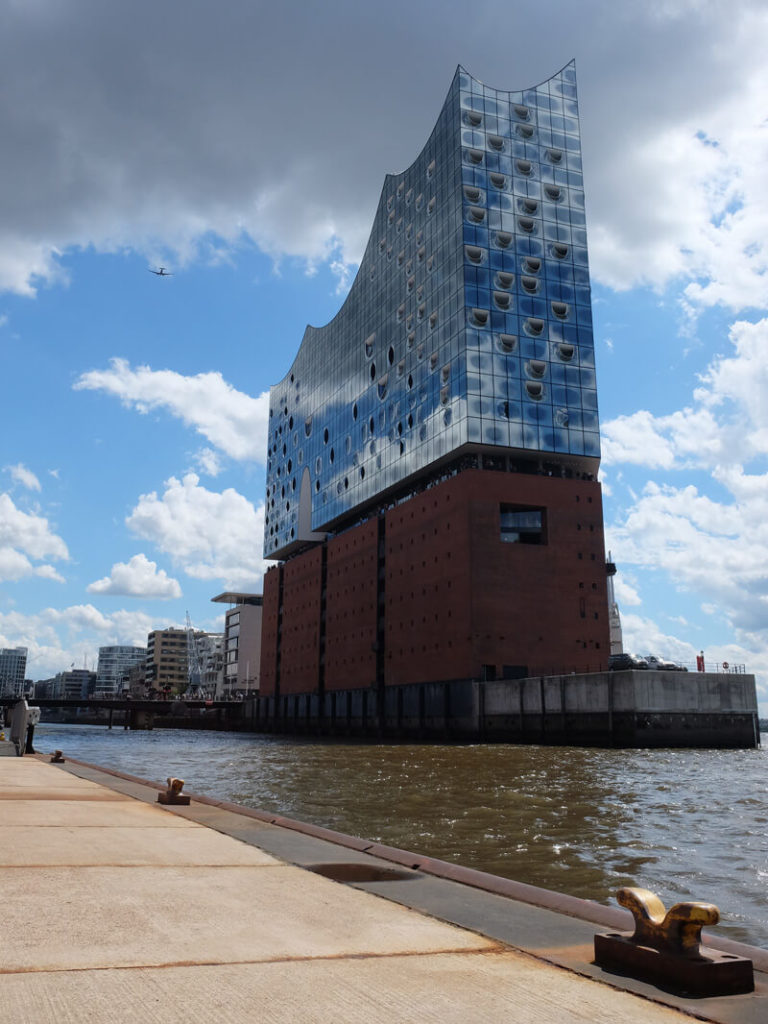
On the edge of the Speicherstadt, where the old, red-brick warehouses meet the shiny new apartments and office blocks of Hafencity, you’ll find a mix of the two. Hamburg’s cutting-edge Elbphilharmonie concert hall was opened in 2017 and is the city’s tallest building. The concert hall sits on top of a 1960s brick warehouse like a glacier, or a great ship – appropriate given its setting, pointing out into the Elbe river. The lower floors are now the Westin Hotel.
You can visit the Elbphilharmonie even if you don’t have a ticket to one of the (mostly classical music) concerts. At the top of the brick part, a viewing platform circles the building, giving fantastic views over the Speicherstadt, the Elbe and the Hamburg skyline. Going up to the Elbphilharmonie viewing platform is one of the most popular things to do in Hamburg.
You’ll need to get a ticket to go up to the viewing platform but these are available either in advance from the Elbphilharmonie website (with a 3 euro booking fee) or free of charge from the Plaza ticket office on Platz der Deutschen Einheit. Once you’ve got your ticket, get your camera ready, as the viewing platform is accessed by one of the world’s most stunning escalators.
4. Take a (budget) boat trip on the Elbe
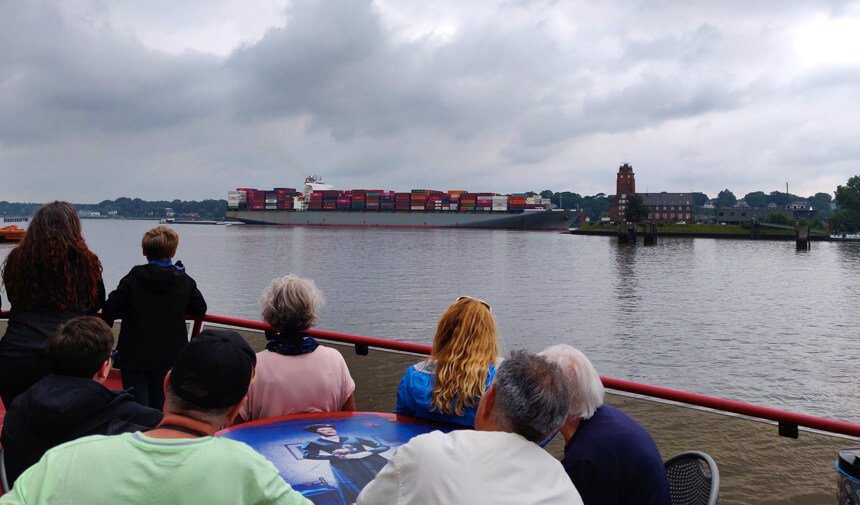
One of the most fascinating things to do in Hamburg is taking a boat trip on the Elbe River. Hamburg is Europe’s third-busiest port, and Hamburg’s wide river is a busy route for enormous container ships, cruise liners, barges, ferries and tourist boats.
There are lots of great tourist boat tours of the Elbe (although make sure you check in advance that the one you’ve chosen is available in English, as many are German-language only), but my favourite way to explore the Elbe was to use the public ferries. Hamburg ferry routes 62 and 72 together take in the most interesting parts of the river, and are a great way to take a Hamburg harbour tour on a budget.
5. Visit the Airbus factory
The plane manufacturer Airbus has a large factory in Hamburg where they assemble the A320 family of aircraft and refurbish the A380 super-jumbo plane. The Airbus factory isn’t far from the Finkenwerder ferry stop, and if you’re lucky you might see one of Airbus’s enormous Beluga cargo planes taking off or coming in to land, carrying plane parts from the other Airbus factories across Europe.
Many visitors to Hamburg don’t realise that you can actually take a guided tour of the Airbus factory in Hamburg. Tours run Monday to Saturday and have to be booked in advance. There is strict security at the Airbus site and all visitors have to show their passport before being allowed in. No photography whatsoever is allowed inside, and mobile phones have to be switched off during the tour. Tours are available in German, English and French.
What you’ll see on the Hamburg Airbus factory tour depends on what aircraft the factory is working on, but you can expect to be able to see the final assembly of Airbus’s narrow-body aircraft and a visit to the production areas for wide-body aircraft, possibly including the A380. It might not be as well-known as some of the other attractions on this list but it’s top of my list of things to do in Hamburg for my next visit.
6. Go to the beach
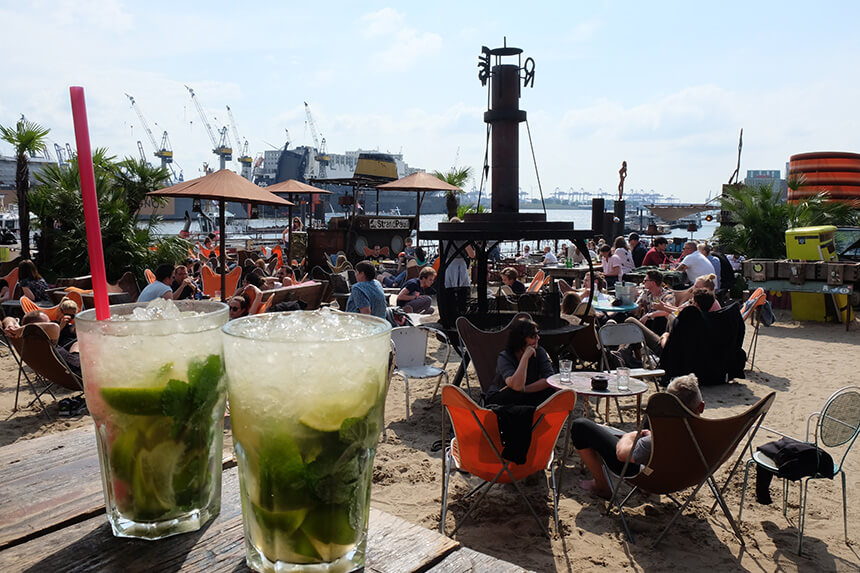
Hamburg is nearly 70 miles from the sea, so you might be surprised to see going to the beach listed as one of the best things to do in Hamburg. On my trip to Hamburg I went to two amazing but very different beaches. The first Hamburg beach I recommend is StrandPauli, a beach club, bar and restaurant with real sand not far from the St Pauli Landungsbrücken ferry terminal. We visited on a beautiful day in June, perfect for sunbathing on one of the many deckchairs, but it’s open all year round – even in winter. An afternoon at StrandPauli is a great way to chill out on your Hamburg city break.
Read about another surprising beach city – Things to do at Amsterdam beach
The other beach I visited in Hamburg was Elbe Strand, near the Neumühlen/Övelgönne ferry stop. This is a really pretty part of Hamburg, with old houses and flower-filled alleyways. There are a few waterside bars and restaurants here, but the main attraction is the wide, sandy, public beach with its backdrop of container ships cruising by. At the far end of the beach you’ll find Der Alte Schwede, a giant glacial boulder that was dredged from the river.
7. Visit villagey Altona
Altona used to be a city in its own right until it became part of the wider Hamburg area in 1937. For much of its history, Altona was a Danish-controlled fishing settlement, and even today it feels quite different to Hamburg city centre just a few miles to the east. The Ottensen district in Altona is more like the centre of a small town than a city, with pretty squares, cafes and interesting shops. It’d be the perfect area to stay in Hamburg if you’re thinking of renting an apartment or AirBnB for your visit as it’s well-connected and homely with plenty of bakeries, greengrocers and supermarkets.
8. Satisfy all your chocoholic desires at Chocoversum
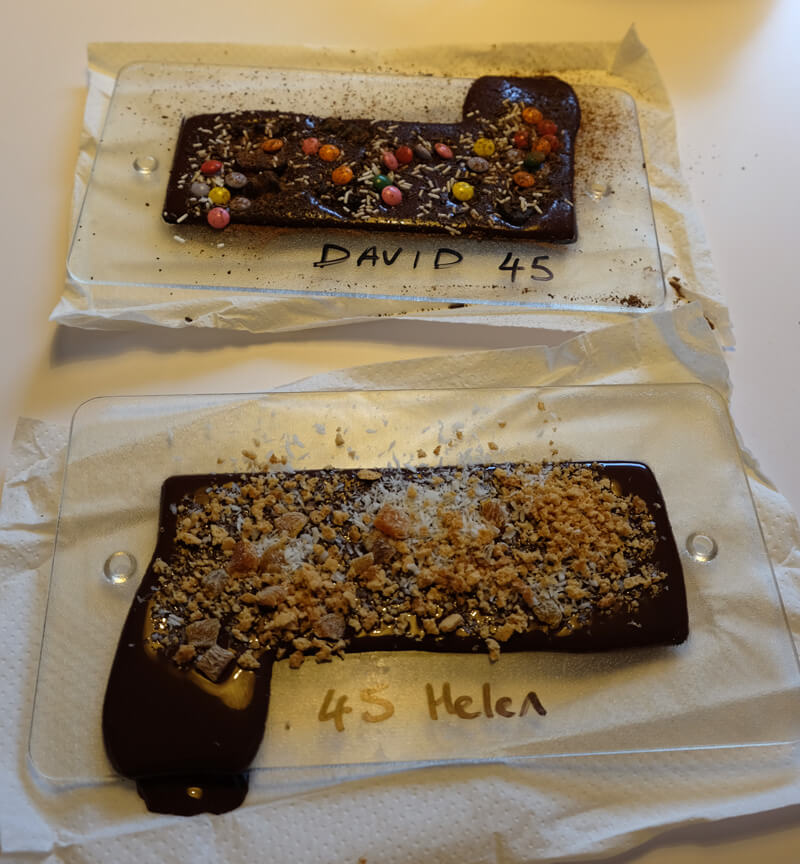
Chocoversum chocolate museum was one of my favourite things to do in Hamburg, and would be perfect for a rainy day. It’s owned by Hachez, Germany’s second-biggest chocolate maker (after Lindt) and you’ll find it in the Chilehaus district, between Altstadt and Speicherstadt. At Chocoversum you’ll take a 90-minute journey through the history and manufacture of chocolate, with plenty of tastings and the opportunity to make your own chocolate bar along the way. It’s a lot of fun for everyone in the family.
Read my full Chocoversum review
9. See the architecture of the Kontorhaus district
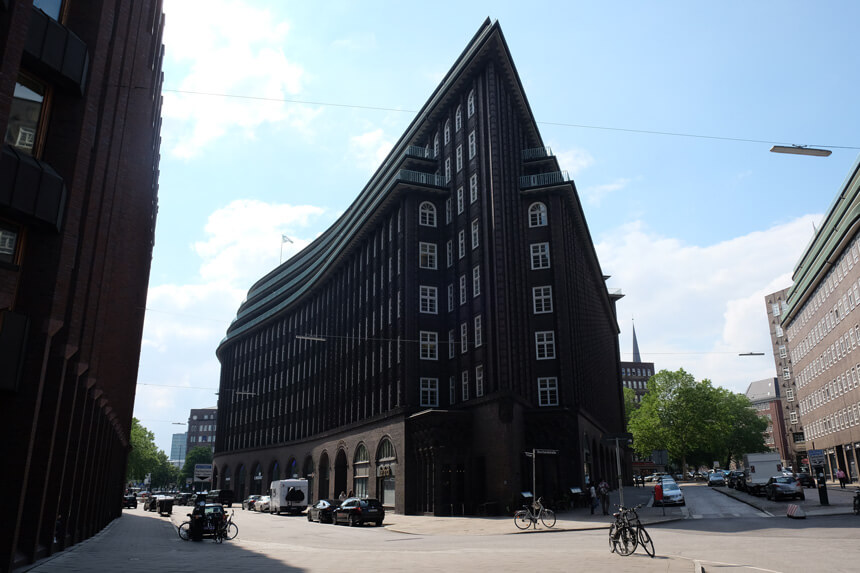
When you visit Chocoversum, don’t miss the stunning architecture of the surrounding Kontorhaus district. The brick office buildings in this area were built in the 1920s in an Art Deco style and are some of the best examples of their type anywhere in the world. They were added to the list of UNESCO heritage sites along with the Speicherstadt in 2015. The central building, Chilehaus, looks like a ship’s prow – go to the junction of Pumpen and Burchardstraße for the best view.
10. Visit “Michel”, symbol of Hamburg
St Michael’s Church, known by Hamburg locals as “Michel”, is Hamburg’s largest church and an icon of the city. The church stands in the Neustadt area of Hamburg but the copper spire topped with a cupola can be seen from all over the city.
After admiring the ornate interior (and if you’re lucky, getting to enjoy the daily trumpet serenade or a choir rehearsal), don’t miss going up the 106-metre-high tower – the tallest clock tower in Germany and one of the best things to do in Hamburg.
From Michel’s observation deck you get a fantastic view of the city – definitely a must-see attraction and one of the top things to do in Hamburg.
11. See the Krameramtswohnungen
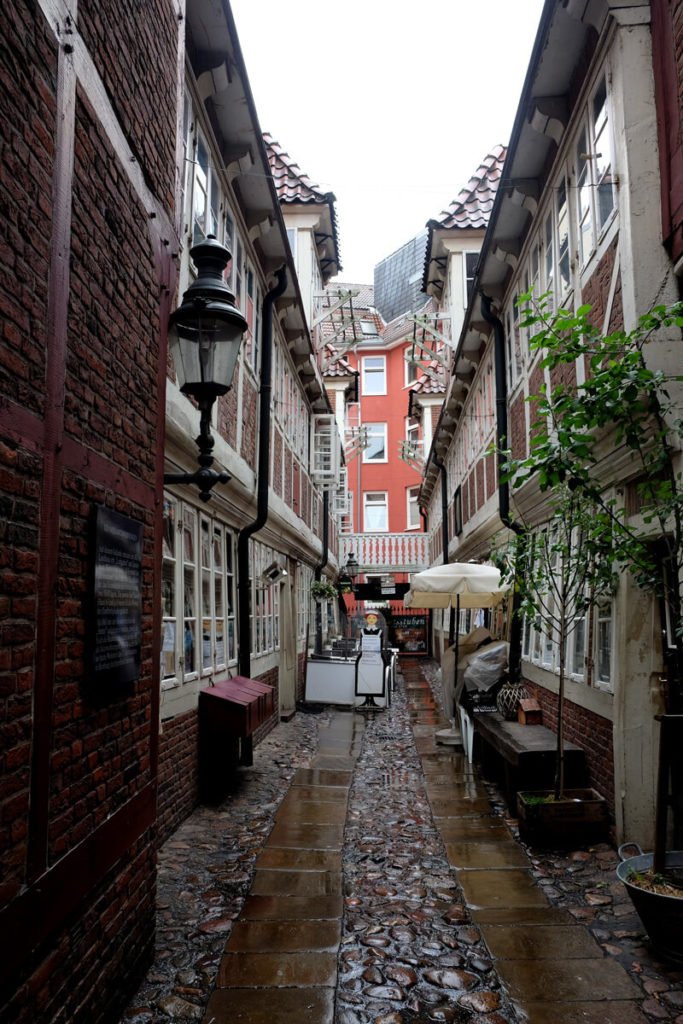
Around the corner from St Michael’s Church, on Krayenkamp street is a little alley. Duck down here and be amazed by the Krameramtswohnungen – a street of tiny, half-timbered houses that date back to the 1600s. They were built as almshouses for widows of members of the Grocers’ Institute.
While much of Hamburg was destroyed during the Second World War (including St Michael’s Church) and had to be rebuilt, the Krameramtswohnungen survived with little damage.
Today the buildings are home to restaurants and quirky shops – spending a little time exploring the area is definitely one of the best things to do in Hamburg.
12. Visit St Pauli and the Reeperbahn
You might want to skip this part if you’re visiting Hamburg with kids, but for most visitors to Hamburg, spending at least a little time in St Pauli will be a must. This area is as iconically Hamburg as Michel and has something for (almost) everyone.
At the centre of St Pauli is the Reeperbahn, a mile-long street that’s one of Hamburg’s liveliest nightlife zones. It’s also its red-light district, and on the Reeperbahn you’ll find nightclubs, bars, sex shops, brothels and strip clubs. As long as you’re ok with that, I recommend coming at least for a look – ideally on a Wednesday, when St Pauli’s night market sets up on Spielbudenplatz. We spent a fun afternoon and evening at the night market, drinking in the beer garden and listening to local live bands.
St Pauli is also where on Sunday mornings you can go to the Fischmarkt. We arrived in Hamburg on a Monday and left on a Friday so we didn’t get to experience the Fischmarkt but it looks like great fun.
13. See where the Beatles played in Hamburg
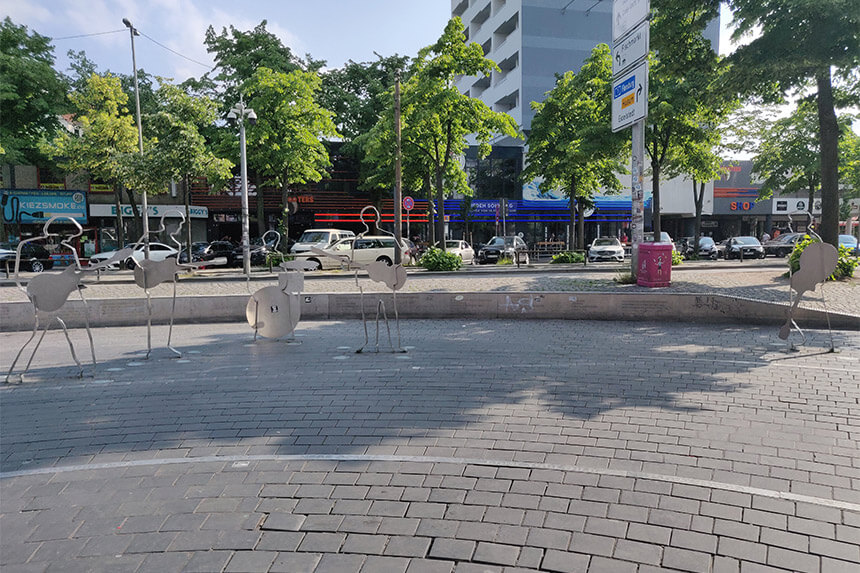
Even if you don’t fancy visiting the Reeperbahn’s after-dark attractions, it’s still worth a trip for its connection with the Beatles. John, Paul and George, plus original members Pete Best and Stuart Sutcliffe performed at venues on and around the Reeperbahn between August 1960 and December 1962, playing for hours every night. George Harrison later described the years in Hamburg as the Beatles’ “apprenticeship”, when they learned “how to play in front of people”. John Lennon said, “I might have been born in Liverpool – but I grew up in Hamburg”.
Of the music clubs where the Beatles played in Hamburg, only the Kaiserkeller remains open (on Große Freiheit street), but you can visit the sites of the Indra Club, the Top Ten and the Star Club. There’s also a square, Beatles-Platz, which commemorates the band’s time in St Pauli. You’ll find the square at the junction of the Reeperbahn and Große Freiheit street; the ground is paved in black tiles to make it look like an old-style vinyl record and four outlined figures holding guitars represent John Lennon, Paul McCartney, George Harrison and Stuart Sutcliffe. A fifth, drumming figure can represent either Pete Best or Ringo Starr.
14. Go onboard a historic ship (or submarine!)
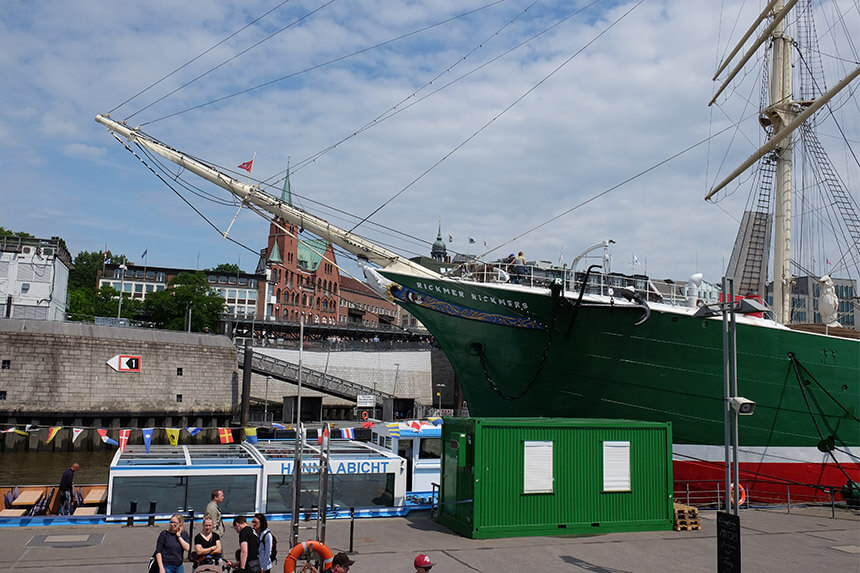
Since shipping is so important to Hamburg, it’s not surprising that lots of attractions in Hamburg are dedicated to boats and the sea. If you also love the sea, you’ll love that some of the top things to do in Hamburg are centred around historic ships.
Rickmer Rickmers is an elegant 1896 cargo sailing ship moored next to the Landungsbrucken ferry terminal; visitors can go on deck, see the tall masts and explore how the crew lived on board.
The Cap San Diego is also a cargo ship but built in 1961, one of the last of the classic old-style vessels from the days before container ships took over. The ship tour takes in the cargo holds, bridge, dining room, galley, crew accommodation, the engine room and the ship’s swimming pool. For true salty sea-dogs, you can even spend the night in one of the lovingly-restored passenger cabins.
Another floating hotel on the Elbe is Das Feuerschiff – a jolly red light ship (floating lighthouse) that helped other vessels into port along the English coastline for 36 years until it was replaced with a giant barrel. It’s now having a second lease of life as a hotel, restaurant, bar and music venue in the shadow of the Elbsphilharmonie.
Museumshafen Oevelgönne is an open-air museum of historic boats from the 19th and 20th centuries. Most of them are small, but there’s an amazing variety of ships, from light ships to steam-powered sea tractors, police boats, cutters, icebreakers and cranes. You can only go inside the boats by appointment, but the collection is an interesting place to visit and is right next door to the Elbe beach. I really enjoyed this area – definitely one of the best things to do in Hamburg.
The U-Bootmuseum is near the St Pauli Fischmarkt and gives visitors the chance to go on board a Soviet submarine from the Cold War for a fascinating and atmospheric experience. Tours are only available in German though, and the small spaces in the submarine mean it’s not for the claustrophobic.
Finally, for something completely different on the water, why not see a theatre performance on a boat? Theaterschiff is exactly what it sounds like – a small theatre on a boat. Performances are in German but there are regular musical shows which might work even if you don’t speak German.
15. Watch the container ships on the Elbe
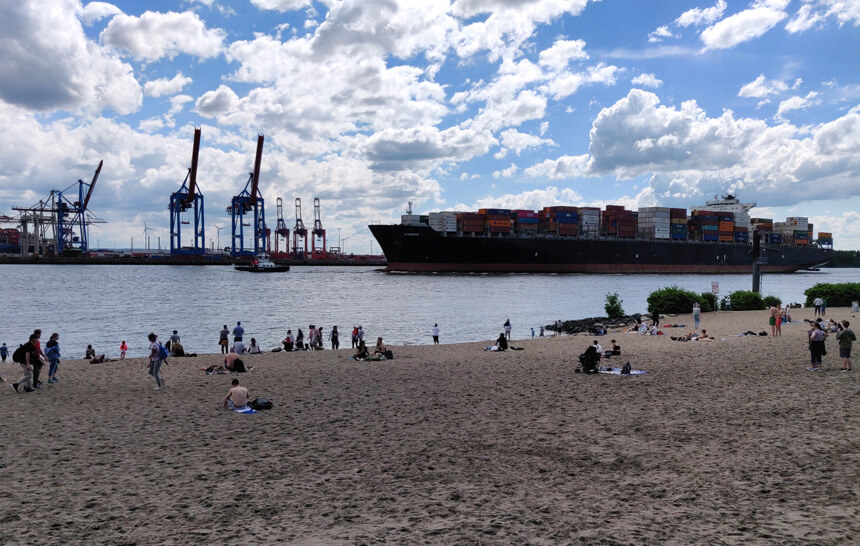
You don’t need to look very far to understand the importance of Hamburg’s port. It might sound daft, but seeing the enormous container ships gliding by and the cranes working away was my favourite free thing to do in Hamburg. Around 10 million containers of goods pass through Hamburg every year from all over the world and I loved watching them being moved around, wondering what was inside.
You can see the ships from anywhere along the Elbe, but relaxing with a cocktail at StrandPauli as they glide past is probably the best way to do it. To add an extra layer of interest (and to find out when the really big ships will be coming past), download a ship-tracking app like VesselFinder or Marine Traffic. These apps show you a map of all the boats around you, and you can click on them to see what they’re called, where they’ve come from and where they’re going.
If you’re staying in Hamburg for more than a few days, and like me, you fall in love with the ships on the Elbe, why not take a trip down the river to the Schiffsbegrüßungsanlage Willkomm-Höft (Ships Greeting Welcome Point). At the Welcome Point, ships arriving or leaving the Port of Hamburg are greeted with a dip of the Hamburg flag while the national anthem of the ship’s country is played on loudspeakers along with a welcome or farewell message in their local language. The Welcome Point has a restaurant and beer garden for visitors.
16. Walk through the St Pauli Elbe Tunnel
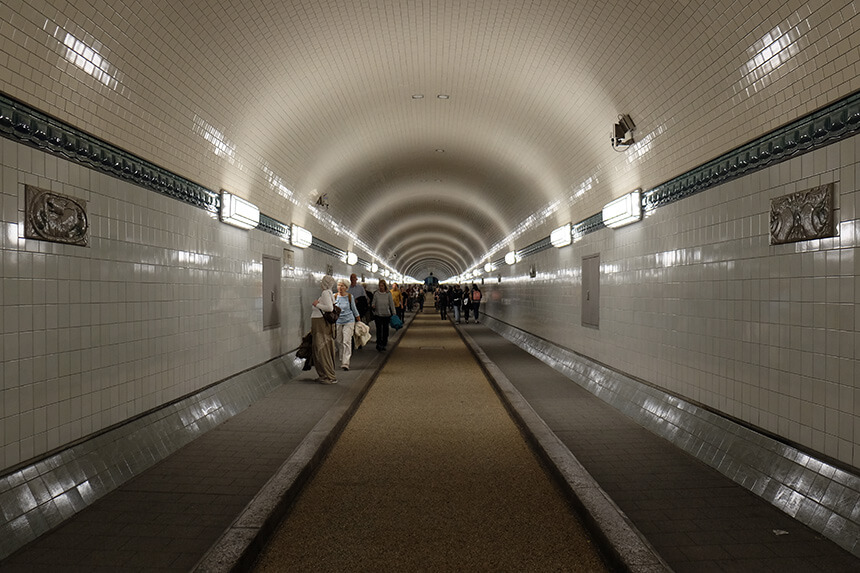
The Old Elbe Tunnel in St Pauli is a vehicle and foot tunnel, built in 1911 to allow people to travel easily from one side of the Elbe river to the other. You might be wondering why a tunnel is a must-see in Hamburg, but there’s as much historical and architectural interest here as there is basic getting-from-one-side-to-the-other utility.
The giant wooden lifts that take cars from street level down to the tunnel are amazing, and the buildings at either end are magnificently cathedral-like, with beautiful Art Nouveau details. All along the 426 m (1,398 ft) long tunnel you’ll see decorative tiles showing fish and other creatures that live in the river above your head.
The St Pauli entrance is next to the Landungsbrücken, so visiting the Elbe Tunnel is easy and convenient for most visitors. I recommend visiting during the times when only foot traffic and bicycles are allowed – I can imagine it being very noisy and fume-y with cars down there. The current pedestrian-only times are Monday-Friday between 8pm and 5.15am, Saturdays after 4pm and all day on Sundays and bank holidays.
Once you’ve reached the other side of the Elbe, there’s a little viewpoint over the river with a food truck selling beer and snacks for a bit of refreshment before you turn around and head back to St Pauli.
17. See some of Hamburg’s oldest buildings on Deichstraße
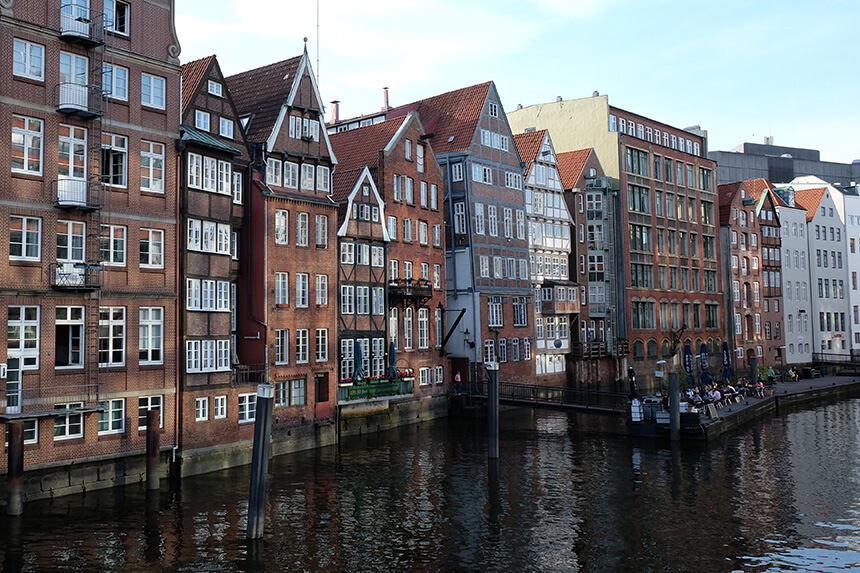
Deichstraße is near the Speicherstadt and is the oldest remaining street in Hamburg’s Altstadt area. The houses on this street date from the 17th to 19th century and allow you to see what the old harbour district used to look like hundreds of years ago. The street backs onto the Nikolaifleet, and the views from the Hohe Brücke at one end and the Holzbrücke at the other are some of the prettiest in Hamburg.
Deichstraße is now home to the Nord Coast Coffee Roastery, famed for its waffles and vegan choices as well as its coffee. Across the street you’ll find Barley & Malt Craft Beer Bar, which has a wide range of interesting ales.
18. St. Nikolai Memorial
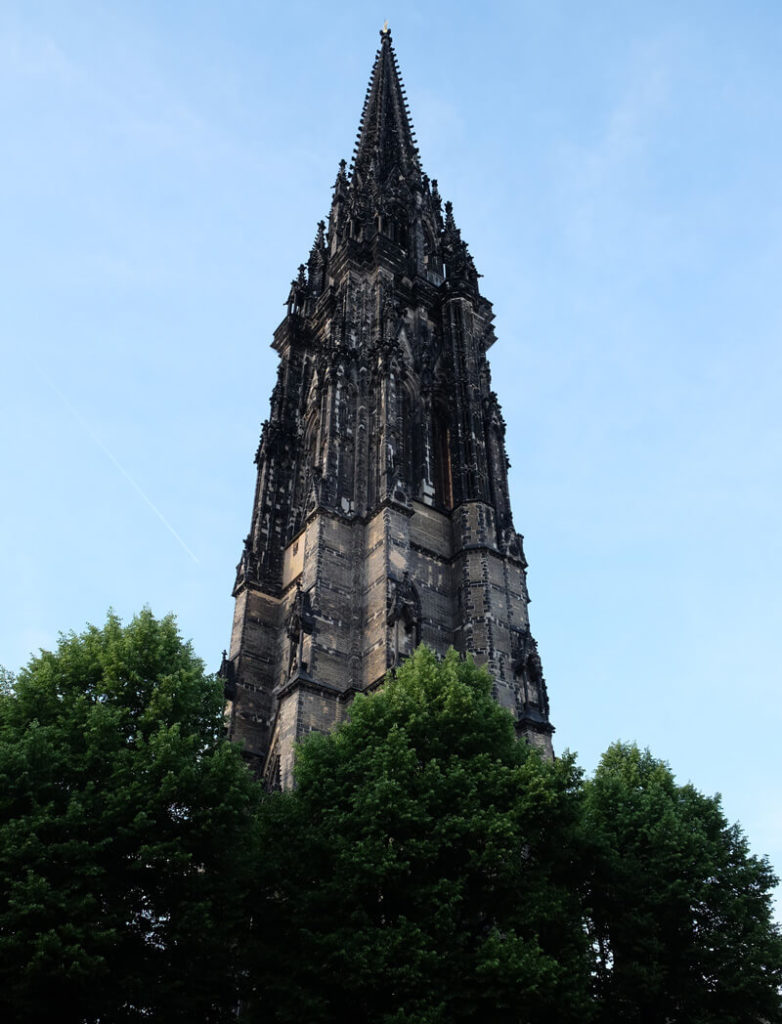
Not far from the top of Deichstraße, across Willy-Brandt-Straße, is the blackened ruin of the St. Nikolai Church. The British architect George Gilbert Scott was awarded the contract to rebuild the church after a fire in the 1840s, and he did so in magnificent Gothic style, making the new church’s spire the tallest structure in Hamburg.
100 years later during the Second World War, that spire was used as a landmark by British bombers to unleash a then-unprecedented firestorm of destruction across the city. Over the course of five terrible nights, a wave of RAF and US Air Force bombs smashed the roofs of Hamburg’s buildings, before a second wave of incendiary bombs set fire to everything inside. Around 34,000 people were killed in the attacks.
Visiting the St. Nikolai Memorial is a sobering reminder of the horrors of war. Informative plaques tell the story of the church and of the bombing of Hamburg. In the crypt there’s a museum commemorating the church and telling visitors about the bombing, along with information about similar German bombings of other cities, including Warsaw and Coventry. The crypt also holds regular events and exhibitions promoting peace and international understanding.
The spire – still the fifth-tallest church tower in the world – now has a viewing platform with pictures showing how Hamburg looked in 1943 as you gaze out over the same view.
19. Relax on Jungfernstieg and the Alster Lake
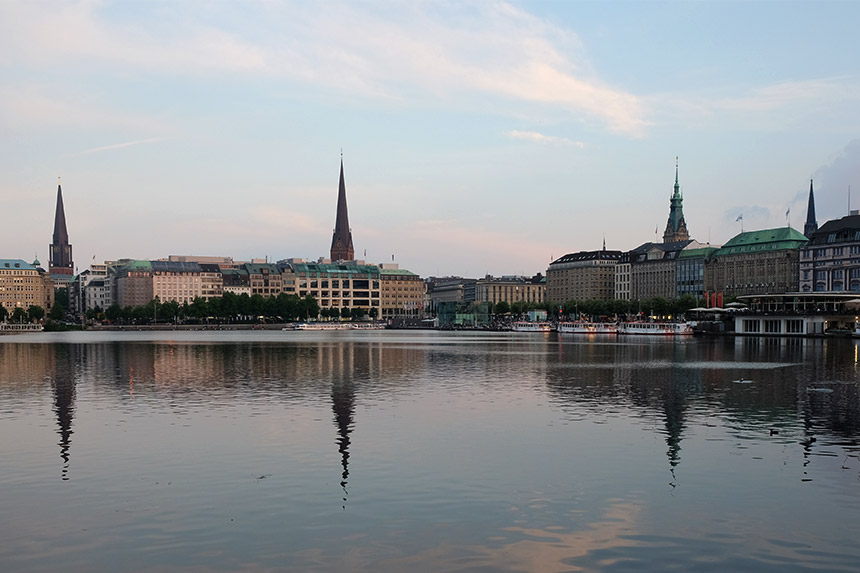
Promenading at the southern end of Hamburg’s Alster Lake has been one of the most popular things to do in Hamburg for hundreds of years. The young unmarried daughters of wealthy Hanseatic families were taken here on Sunday afternoon excursions, and it’s still a lovely place to see and be seen, with plenty of seating alongside the lake and a range of luxury shops for some retail therapy. In the centre of the waterfront, Café Alex is a Hamburg institution, serving drinks with a view since 1799.
The inner Alster lake (Binnenalster) makes for a pleasant circular stroll, while you can explore the outer Alster lake (Außenalster) either on one of the traditional white Alster tourist boats or under your own steam by renting a stand-up paddleboard, canoe or pedal boat.
20. Be impressed by the grand City Hall
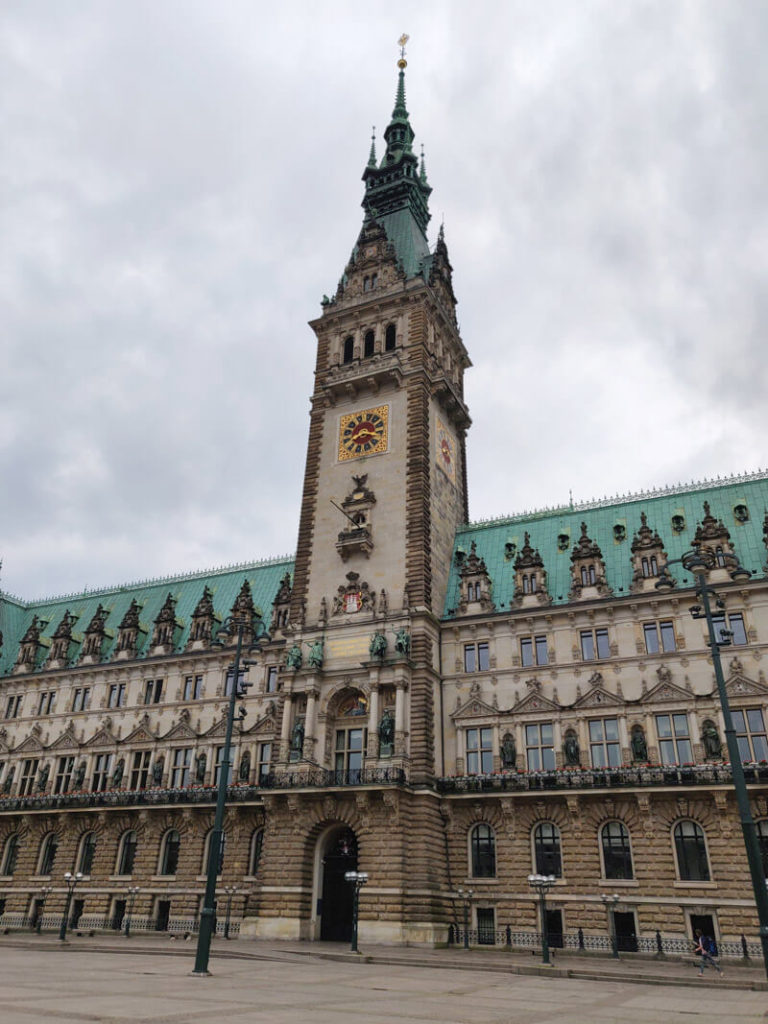
Hamburg’s huge and intimidatingly-grand City Hall was built between 1886 and 1892, and has a whopping 647 rooms. Visitors can take a look inside to see one of the regular exhibitions, or for a more in-depth look you can take a guided tour.
21. Take a tour of Hamburg airport
Your trip to Hamburg is likely to start and end at Hamburg Airport, so why not build it into your sightseeing schedule? Hamburg Airport has a Miniatur Wunderland-style attraction of its own in the model airport, and you can even take a tour of the airfield, getting up close to passenger and cargo aircraft, seeing the runway and visiting the airport’s fire brigade.
Search for places to stay in Hamburg on the map below.
I hope you’ve enjoyed this post about things to do in Hamburg. If your favourite things to do in Hamburg and Hamburg attractions aren’t on this list, let me know!
Pin things to do in Hamburg for later!
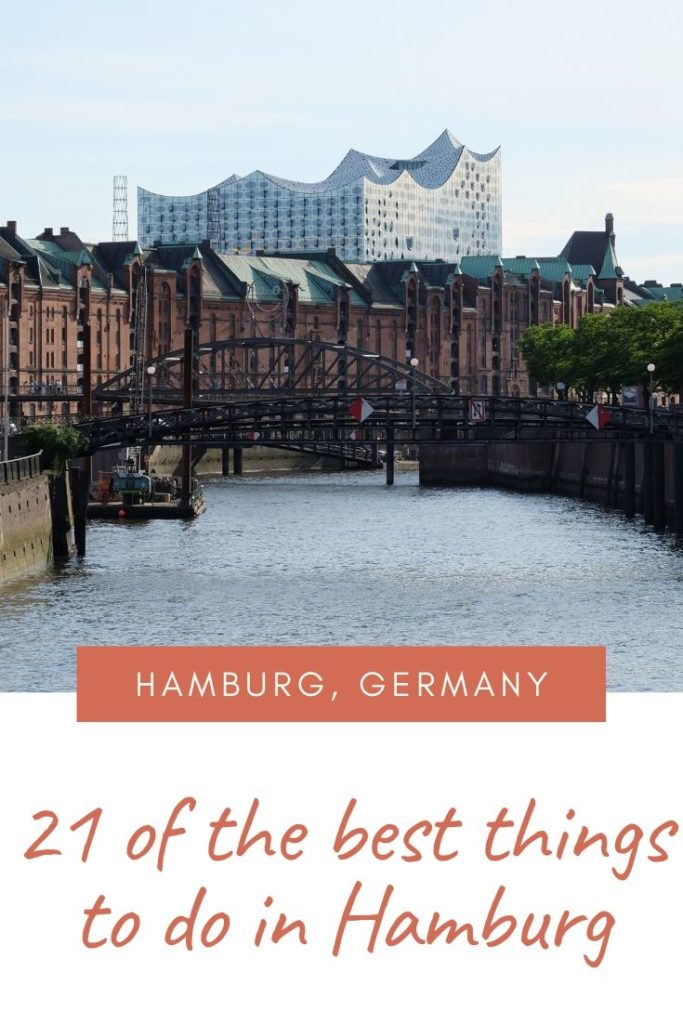


Your site has been really helpful while planning my trip to Hamburg. Thanks!
Thanks Scott, glad you found it useful!
Great article about Hamburg, thanks for the information!
Thanks Adri!